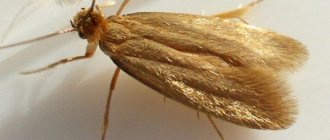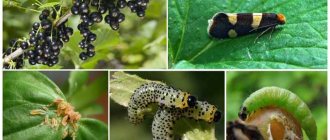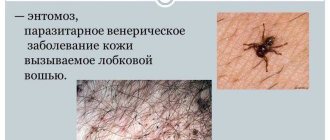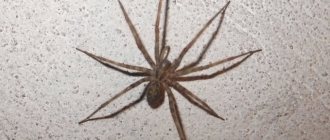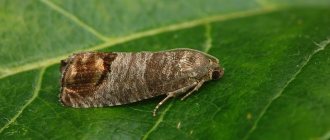Mosquitoes in autumn
It is known that as soon as the summer heat gives way to the September cold snap, the number of mosquitoes on the street decreases sharply. As is known, a huge part of these insects die after laying the first eggs. Those mosquitoes that survive are looking for comfortable places where they can easily spend the winter. These blood-sucking insects in autumn and winter can be found in the bark of dry trees and hollows, in grass, moss, burrows, various deep caves, and so on. They tolerate winter cold without any difficulties at any stage of development, no matter whether it is an adult, larva or pupa. Mosquitoes in the basement or cellar will quietly overwinter, and as soon as warm summer days arrive, they will leave the shelter and go hunting.
Diapause in the life of mosquitoes
We are getting closer to the answer to the question of where butterflies and mosquitoes hide for the winter. The winter period in the life of these insects is called diapause. During this period of life, blood-sucking squeaks do not feed, and if this does not happen, then the individual cannot reproduce. But there are exceptions! If mosquitoes spend the winter in damp and warm basements of private or multi-story buildings, then they are still active. Adults find food for themselves, thanks to this the reproduction process continues, and they lay eggs. Therefore, if you go down to the cellar for potatoes, you will meet a mosquito even in the most severe January frosts. Now you know where mosquitoes spend the winter.
Seasonal changes in insect behavior
The life of insects is directly dependent on many factors - temperature, humidity, food, light, etc. Being ecologically plastic, insects easily adapt to any habitat conditions. In our temperate climate, with sharp fluctuations in the most important environmental factors throughout the year, in the process of evolution, insects have developed adaptive reactions to the changing seasons. Thanks to them, these creatures can live and develop in different weather conditions. And this, in turn, is reflected in seasonal cycles specific to each species.
Behavior in autumn.
Autumn is not the most favorable time for the life of insects, on the one hand, due to weather conditions, on the other, due to the lack of food. Unstable weather with sudden changes in temperature - from warm days to frost, as well as heavy rains negatively affect their activity. In addition, in the fall, plants stop growing and developing, and they become unsuitable for nutrition. Therefore, many insects have an active life in spring and the first half of summer, when plants contain a large amount of nutrients.
And by the end of autumn, most insects are already in a state of winter dormancy. But in some, especially cold-resistant species (winter moth, red pine sawfly, winter mosquito and some others), active life can continue until late autumn and even until the beginning of winter.
Depending on their behavior in autumn, insects are divided into 2 groups:
1. Adult forms die, and larvae, pupae, and eggs remain to overwinter.
2. Remain to overwinter as adults: butterfly, mourning butterfly, peacock's eye, ladybugs, ground beetles, dung beetles, ants).
Behavior in winter.
In winter, insects are dormant, which allows them to survive the unfavorable period. Their active life (growth, development, reproduction) occurs in the warm season and lasts from early spring to late autumn - 6-7 months. But this is not the end of insects’ preparation for winter. They still have to solve a number of vital issues - where, in what places and in what shelters they will spend the winter.
In this case, conditions favorable for overwintering must be created specifically for the overwintering phase, and eggs, larvae, pupae, and even adult insects themselves can overwinter in different insects. The methods of protection from the winter cold of these small creatures are so varied and numerous that sometimes you are simply amazed at their ingenuity.
A very important point is the choice of wintering location. Wherever do insects hibernate? These can be trees and shrubs, dry plants, walls of various buildings, fences, the soil surface and the soil itself. In some species, the overwintering phases are located on the trunks and branches of trees on the bark and under the bark, in cracks in the bark, under the scales of the buds and at their base. This is how the eggs of aphids, honey moths, gypsy and ringed silkworms, and the winter moth overwinter; caterpillars of cherry moth, hawthorn moth, codling moth, cabbage and turnip moth pupa, etc.
Cruciferous bugs, apple flower beetle, weevils (raspberry-strawberry, etc.), cruciferous flea beetles, gooseberry moth, yellow gooseberry sawfly, cabbage flies and many others hide on the surface of the soil in the litter, under fallen leaves, clods of earth and in its upper layers. Some species go to great depths - up to 15 cm and deeper (apple sawfly, raspberry beetle, etc.). The Colorado potato beetle can be found even at a depth of 20-30 cm.
Behavior in spring.
Insects that hibernate as adults begin to awaken. Flies and butterflies wake up first.
Butterflies in winter
These beautiful creatures are less fortunate than mosquitoes. The thing is that the butterfly's lifespan is very short. In nature, there are species that die a few hours after emerging from the pupal stage. Some live a little longer - about a day. Butterflies that can survive winter are very rare! As a rule, these are large-winged insects; they are born in the autumn. Butterflies belong to the order Lepidoptera; their main way of surviving winter is the pupal stage. Their small cocoon can be found in secluded places, namely in plants and grass, as well as in fallen leaves.
But there are also cases when the cocoon is attached to a tree branch. There are species of butterflies that overwinter as adults. These include lemongrass butterflies. They can be found under the bark of a tree. In difficult and frosty times, lemongrass goes into suspended animation, that is, it hibernates. During this period, the butterfly does not develop. It is known that spring and summer do not come immediately, but gradually. During the period of a slight thaw, the butterfly wakes up, but it is no longer able to survive the next cold snap. Thus, the lemongrass butterfly dies. Now you know where butterflies and mosquitoes hide for the winter.
Seasonal changes in the life of insects.
The life of insects is directly dependent on many factors - temperature, humidity, food, light, etc. Being ecologically plastic, insects easily adapt to any habitat conditions. In our temperate climate, with sharp fluctuations in the most important environmental factors throughout the year, in the process of evolution, insects have developed adaptive reactions to the changing seasons. Thanks to them, these creatures can live and develop in different weather conditions. And this, in turn, is reflected in seasonal cycles specific to each species.
Behavior in autumn.
Autumn is not the most favorable time for the life of insects, on the one hand, due to weather conditions, on the other, due to the lack of food. Unstable weather with sudden changes in temperature - from warm days to frost, as well as heavy rains negatively affect their activity. In addition, in the fall, plants stop growing and developing, and they become unsuitable for nutrition. Therefore, many insects have an active life in spring and the first half of summer, when plants contain a large amount of nutrients.
And by the end of autumn, most insects are already in a state of winter dormancy. But in some, especially cold-resistant species (winter moth, red pine sawfly, winter mosquito and some others), active life can continue until late autumn and even until the beginning of winter.
Depending on their behavior in autumn, insects are divided into 2 groups:
1. Adult forms die, and larvae, pupae, and eggs remain to overwinter.
2. Remain to overwinter as adults: butterfly, mourning butterfly, peacock's eye, ladybugs, ground beetles, dung beetles, ants).
Behavior in winter.
In winter, insects are dormant, which allows them to survive the unfavorable period. Their active life (growth, development, reproduction) occurs in the warm season and lasts from early spring to late autumn - 6-7 months. But this is not the end of insects’ preparation for winter. They still have to solve a number of vital issues - where, in what places and in what shelters they will spend the winter. In this case, conditions favorable for overwintering must be created specifically for the overwintering phase, and eggs, larvae, pupae, and even adult insects themselves can overwinter in different insects. The methods of protection from the winter cold of these small creatures are so varied and numerous that sometimes you are simply amazed at their ingenuity. A very important point is the choice of wintering location. Wherever do insects hibernate? These can be trees and shrubs, dry plants, walls of various buildings, fences, the soil surface and the soil itself. In some species, the overwintering phases are located on the trunks and branches of trees on the bark and under the bark, in cracks in the bark, under the scales of the buds and at their base. This is how the eggs of aphids, honey moths, gypsy and ringed silkworms, and the winter moth overwinter; caterpillars of cherry moth, hawthorn moth, codling moth, cabbage and turnip moth pupa, etc. Cruciferous bugs, apple flower beetle, weevils (raspberry-strawberry, etc.), cruciferous flea beetles, gooseberry moth, yellow gooseberry sawfly, cabbage flies and many others hide on the surface of the soil in the litter, under fallen leaves, clods of earth and in its upper layers. Some species go to great depths - up to 15 cm and deeper (apple sawfly, raspberry beetle, etc.). The Colorado potato beetle can be found even at a depth of 20-30 cm.
Behavior in spring.
Insects that hibernate as adults begin to awaken. Flies and butterflies wake up first.
Ladybug
- Appearance
Small beetles with a strongly convex rounded body. The underside of the body is flat. The head is very small. The color is bright from contrasting black, yellow, red tones. The legs are thin, short, and black. Disturbed beetles secrete a sharp-smelling yellowish, poisonous liquid that repels enemies. Mostly predators.
- Behavior by season
Closer to autumn, ladybugs go to wintering grounds in flocks. Some of them, 4-5 pieces each, are located in a leaf rolled into a tube, fall to the ground with it and overwinter under fallen leaves. Others wait for spring between the needles of pine needles, while others wait under the bark of an old tree.
After overwintering, females lay several hundred eggs in the spring on the undersides of leaves. After about a week, the larvae hatch. After several molts, after 1-2 months, they pupate and after 6-9 days adults appear.
- Nutritional nature
One larva or beetle eats up to 50 aphids per day.
- Meaning in nature
Predatory species destroy aphids, scale insects, psyllids and other dangerous pests of garden and vegetable crops. Few species are herbivorous and can harm crops.
Krasotel fragrant
- Appearance.
The fragrant beetle is a large beetle from the ground beetle family. Predator. It is distinguished by beautiful bright bluish-green, sometimes golden-green elytra with several rows of dots and a pungent odor that the beetle emits in case of danger. The color of the lower part of the body is blue or black-blue. The head and pronotum are dark blue or blue-green.
In appearance, this large beetle, sometimes over 3 cm long, is one of the most beautiful representatives of our fauna of coleopteran insects. Hence its Russian generic name - krasotel.
- Behavior according to the seasons of the year.
The usual fertility of the beauty beetle is about 100 eggs. With an abundance of food, females begin to lay more eggs, and the number of predators increases rapidly.
Larvae emerge from eggs laid in the soil after 4–7 days.
Adult beetles can live up to 4 years. They spend winters in the soil. Preparation for wintering begins at the end of summer, soon after their main food - caterpillars and lepidopteran pupae - disappears.
The female mates several times during the year. Beetles fly well, especially in spring. At this time, they are actively searching for their prey, migrating over very long distances.
- Nature of nutrition.
Adult beetles and larvae are active predators; they destroy caterpillars and pupae of various butterflies en masse. The beauty is tough on the extremely hairy caterpillars, which even insectivorous birds avoid eating. These are primarily the caterpillars of such a dangerous and widespread pest of deciduous plants as the gypsy moth. During the season, the family of the odorous beetle (“father” beetle, “mother” beetle and their offspring - larvae) destroys 5-6 thousand gypsy moth caterpillars. For this, he rightfully earned the laurels of the winner of the silkworm and is considered an ally of foresters.
When pests appear en masse in coniferous plantations, the beetle appears there too. At the same time, it attacks the caterpillars of moths and moths. There is more than one known case of mass appearances of these ground beetles in breeding areas of the dangerous pest of coniferous forests, the nun silkworm.
The larvae differ little from the adult beetle in their aggressiveness and feeding habits. But for some time the white newborn larva remains in the egg cradle. She stays here for a short time - exactly until her covers become shiny black. After this, she climbs to the surface of the soil and begins to look for food. Larvae hunt both day and night, although they are more active in hot weather. The head of the larva is equipped with the same strong jaws as those of the beetle itself. Each jaw has a sharp tooth on the inside, thanks to which, once it has grabbed the prey, it does not release it until it has sucked out all the contents.
In many cases, the larva eats only a small part of the victim's body, which is why the latter, of course, dies. During its development, the larva moults twice, and then burrows into the ground and pupates.
The favorite objects of hunting and source of food for the beauty are the caterpillars that live in the crowns of trees. The beetles also attack the butterflies themselves, perched on a trunk or branch to rest. Having grabbed the dozing beauty, the beetle kills her, gnawing into the abdomen of the unfortunate woman, often eating the eggs not yet laid by the female.
This active predator does not hesitate to attack animals that are not inferior to it in size. Running nimbly along tree trunks, it looks for a wide variety of small insects. But if he encounters a beetle that is even larger than him, he will also attack him. Having grabbed a large prey, the beetle descends from the crown to the forest floor, where it begins to eat, no longer fearing to lose its prey.
Climbing into tree crowns behind caterpillars, the beetle does not disdain food that is completely unusual for other predatory insects: there are cases when beetles attacked fledgling chicks in nests
Krasotel can not only attack - he defends well. In addition to an effective “weapon” in the form of powerful mandibles, nature provided it with an equally advanced weapon of defense. If an enemy appears, the beetle turns its rear end of its body towards him and throws upward a stream of poisonous liquid. When it gets on the skin or mucous membrane, it causes severe irritation and itching. That is why it is not recommended to hold the caught beetle with its back end towards you, and after working with beetles you should wash your hands thoroughly. It was for the sharp unpleasant smell of the secreted secretion that it received its main Russian species name.
- Habitat.
Krasotel is found in gardens and deciduous forests in the south and west of the European part of Russia, as well as in the Caucasus, Crimea, Western Europe and in the mountains of Central Asia, Eastern Kazakhstan, North-West China, and North Africa. It rises into the mountains to heights of 1500-2000 meters above sea level.
Unlike other ground beetles, the permanent habitat of the species is not soil, but trees. We can say that he lives not in a two-dimensional flat space of fields and meadows, like the rest of his relatives, but in a three-dimensional one, hunting on the ground and prowling the crowns of tall trees in search of prey.
Notes
The number is unknown. There is a direct dependence of the number of beauties on the number of gypsy and ringed silkworm caterpillars and other leaf-eating insects that serve as food for them.
Scientists' alarm
Over the past few decades, experts have come to the conclusion that a huge number of butterflies are leaving their natural habitat. They fly to big cities. This is due to the fact that urban objects emit heat, which attracts lepidoptera. They settle in basements, on the roofs of houses and factories. Due to the fact that the butterfly does not fall into suspended animation, it soon dies. These facts worry scientists more and more.
Butterflies bring enormous benefits to the flora world. They are in second place in plant pollination after bees! Did you know that a butterfly only tastes food when it stands on it?! The thing is that the taste buds of lepidopterans are on their paws!
Our article has come to an end. You learned where butterflies and mosquitoes hide for the winter, as well as what happens to insects during the cold season.




